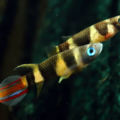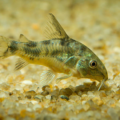When it comes to aquarium fish, aggression can be a major concern for many hobbyists. The last thing you want is to introduce a fish species that will disrupt the peaceful environment of your tank. If you’re considering adding Kuhli Loaches to your aquatic community, you may be wondering: Are Kuhli Loaches aggressive?

Understanding Kuhli Loaches
Kuhli Loaches, scientifically known as Pangio kuhlii, are a popular and intriguing fish breed native to Southeast Asia. These eel-like loaches have long, slender bodies and exhibit a fascinating behavior of burrowing and hiding in the substrate. With their unique appearance and behavior, Kuhli Loaches make for an interesting addition to any aquarium.
Physically, Kuhli Loaches typically grow to around 3-4 inches in length. They have a beautiful pattern of dark brown or black stripes running horizontally across their bodies. This distinctive marking gives them a stylish appearance that can add visual interest to your tank.

Behavior of Kuhli Loaches towards Other Fish
When it comes to interactions with other fish breeds, Kuhli Loaches are known for their peaceful nature. They are generally non-aggressive and prefer to live in schools of at least three fish. In fact, being a social species, Kuhli Loaches feel more comfortable and exhibit their natural behaviors when kept in groups.
Kuhli Loaches are compatible with other small, peaceful fish species, making them an ideal choice for community tanks. They are known to coexist peacefully with species like tetras, guppies, and rasboras. However, it’s essential to note that aggressive or larger-sized fish may intimidate Kuhli Loaches, causing stress and potential aggression.

Factors that Influence Aggression in Kuhli Loaches
While Kuhli Loaches are generally peaceful, certain factors can influence their behavior and potentially trigger aggression. It’s crucial to understand these factors to create a suitable environment for your loaches and maintain a harmonious tank.
The size of the tank is important when it comes to minimizing aggression in Kuhli Loaches. These fish need ample space to explore and establish territories. A tank of at least 20 gallons is recommended for a small school of Kuhli Loaches. Due to their average kuhli loach size of 3-4 inches (including the sleek black kuhli loach), these fish are excellent additions to smaller community aquariums also.
Water parameters and quality also play a significant role in their behavior. Kuhli Loaches prefer slightly acidic to neutral water with temperatures ranging from 75 to 86 degrees Fahrenheit. It’s essential to maintain clean water conditions and perform regular water changes to keep them stress-free.
Feeding habits and diet can also impact their behavior. Kuhli Loaches are primarily bottom-dwellers and enjoy scavenging for food. Providing a varied diet that includes sinking pellets, frozen or live foods, and occasional vegetable matter can keep them healthy and prevent aggression resulting from competition for food.

Understanding Aggression in Kuhli Loaches
While Kuhli Loaches generally exhibit peaceful behavior, it’s important to be aware of signs of potential aggression. This includes chasing or nipping at other tankmates, particularly during feeding times or when defending their territories. Aggression can also be observed if they feel threatened or overcrowded due to inadequate hiding spots or a lack of space.
Managing Aggression in Kuhli Loaches
If you notice any signs of aggression in your Kuhli Loaches, there are measures you can take to manage and minimize it:
First and foremost, providing ample hiding spots and shelters within the tank is crucial. Kuhli Loaches are natural burrowers and appreciate places to retreat and feel secure. This can be achieved by incorporating caves, driftwood, and plants into the aquarium setup.
Creating a balanced and diverse aquarium environment helps reduce aggression in Kuhli Loaches. Adding a variety of plant life and different levels in the tank can create territories and prevent overcrowding. This allows each fish to establish their own space, minimizing stress and potential aggression.
Addressing any potential stressors in the tank is essential. This includes maintaining proper water parameters, providing a suitable diet, and avoiding overcrowding. By ensuring a stress-free environment, you can help promote peaceful behavior in Kuhli Loaches.
Is the Kuhli Loach a Suitable Pet Choice?

Kuhli loaches are fascinating freshwater fish gaining popularity among aquarists. These eel-like, bottom-dwelling fish offer unique personalities and low-maintenance charm. They boast beautiful stripes or spots, with black kuhli loaches being a popular variety (alongside the leopard loach). While adult kuhli loaches reach a modest size (making them ideal for smaller tanks), their average kuhli loach lifespan is an impressive 10 years.
Breeding kuhli loaches is challenging in home aquariums, as female kuhli loaches are tricky to distinguish and conditions must be perfect. Kuhli loach eat various foods, including sinking pellets and freshly hatched brine shrimp.
Overall, most kuhli loaches thrive in peaceful community fish tank. Though shy, pairing kuhli loaches in groups encourages them to be more active. Remember, wild kuhli loaches often grow slightly larger than their captive-bred counterparts.
Conclusion
In conclusion, Kuhli Loaches are generally non-aggressive and peaceful fish that can coexist harmoniously in a community tank. However, it is important to consider factors such as tank size, water parameters, and diet to prevent any potential aggression. By understanding their behavior and providing a suitable environment, you can enjoy the fascinating presence of Kuhli Loaches in your aquarium without any aggressive encounters.










